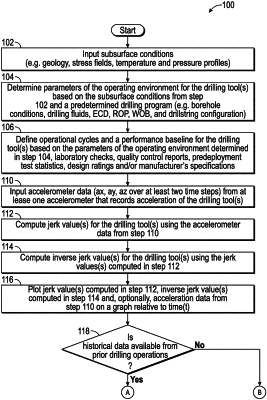| CPC G05B 19/4065 (2013.01) [E21B 44/00 (2013.01)] | 20 Claims |

|
1. A computer-implemented method for determining drilling tool failure thresholds, the method comprising:
receiving a plurality of acceleration values from an accelerometer coupled with a drilling tool disposed within a wellbore;
calculating a plurality of jerk values and a plurality of inverse jerk values based on the plurality of acceleration values;
inputting a plurality of subsurface conditions and a plurality of operating conditions corresponding to the wellbore, wherein the plurality of operating conditions are determined using a drilling program;
generating a graph including the plurality of acceleration values and the plurality of inverse jerk values relative to time;
receiving historical drilling tool data corresponding to a second wellbore in a geographically similar area;
performing a simulation on the historical drilling tool data using a data driven model simulation to determine historical drilling tool failure data;
updating the graph to include the historical drilling tool failure data; and
determining a plurality of drilling tool failure threshold limits based at least in part on the graph.
|